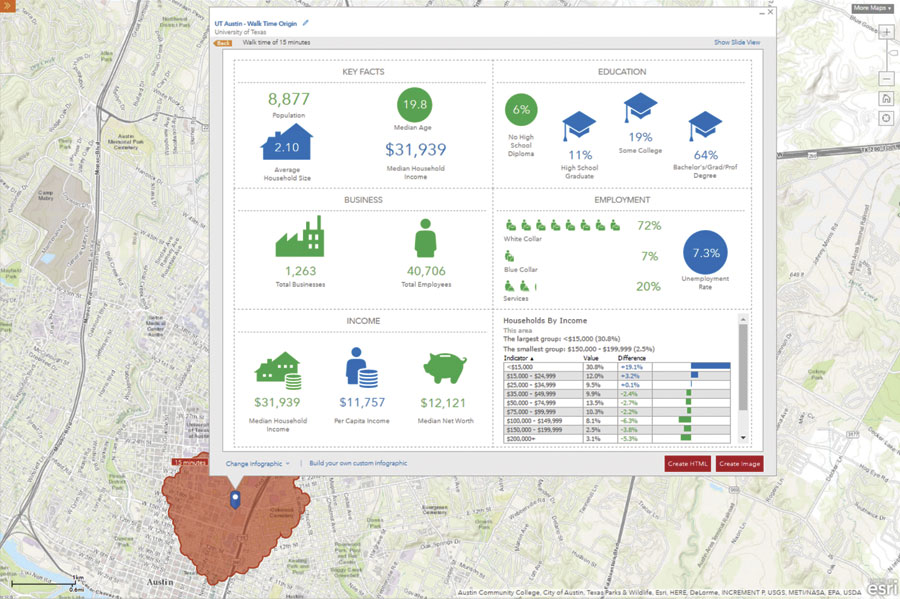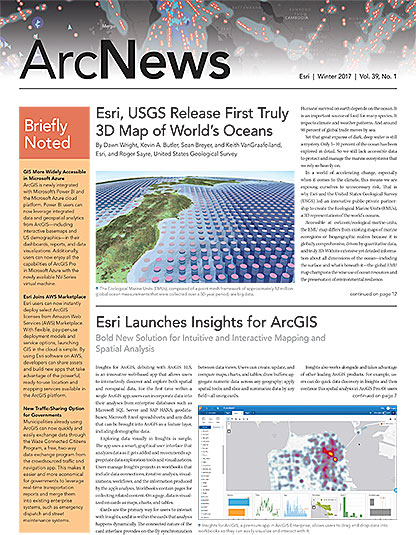ArcGIS 10.5 provides new capabilities that enhance analytics and problem-solving and make it easier to connect to and integrate many types of enterprise data with ArcGIS. The most significant change with the 10.5 release of ArcGIS is ArcGIS Enterprise.
ArcGIS Enterprise is the new name of the ArcGIS for Server product family that includes ArcGIS GIS Server, Portal for ArcGIS, ArcGIS Data Store, and ArcGIS Web Adaptor. ArcGIS Enterprise offers new features that take Esri server software to a whole new level.
Getting Started
To get started with ArcGIS Enterprise, users create a base ArcGIS Enterprise deployment. A base deployment is the configuration of the four software components—ArcGIS GIS Server, Portal for ArcGIS, ArcGIS Data Store, and ArcGIS Web Adaptor—into a functional Web GIS that lives on an organization’s own infrastructure. The base deployment can be configured with all components on a single machine or with components distributed across multiple machines in a multitier configuration. ArcGIS Enterprise can always be deployed with high availability as well.
Server Roles
From the single ArcGIS Server software component, users can license the specific server capabilities their organizations need through server roles. At ArcGIS 10.5, there are five server roles: ArcGIS GIS Server, ArcGIS Image Server, ArcGIS GeoEvent Server, ArcGIS GeoAnalytics Server, and Esri Business Analyst Server. These five server roles provide an off-the-shelf solution that feels completely custom. Each server role added to the base ArcGIS Enterprise deployment can be scaled independently. ArcGIS Enterprise can be deployed on any infrastructure that meets the minimum system requirements so it can be architected to align with any organization’s technology road map.
The GIS Server role captures everything ArcGIS for Server was in prior software releases. It provides the same service types and allows the same analytical capabilities. GIS Server is offered in Basic, Standard, and Advanced editions and at the Workgroup level. Users will still be able to extend and customize the functionality of the GIS Server through Esri-built extensions or through custom written server object extensions and interceptors. It powers Web GIS behind a firewall, but it can also be used in dedicated server sites to support specific functions for an organization such as mapping and visualization and maintaining workload separation for optimal system performance.

At ArcGIS 10.5, ArcGIS Image Extension for Server has been replaced by the Image Server role. It provides everything the extension offered but also introduces Raster Analytics. By harnessing the power of distributed and parallelized computing, Raster Analytics can produce pervasive, full-resolution raster/imagery outputs in a fraction of the time previously required. Users can run simple raster analysis tools or chain together analytical functions to create raster models to answer even the most complex questions. Whether the data resides in a data center or in the cloud, Image Server has many options for connecting to existing raster and imagery libraries.
GeoEvent Server, which replaces ArcGIS GeoEvent Extension for Server, serves the same purpose and has the same analytical horsepower as its predecessor. GeoEvent Server is designed to handle high-volume, high-velocity real-time and streaming data. It provides solutions through on-the-fly analysis and dynamic aggregation of large datasets, which makes data visualization easy. When connected to the base ArcGIS Enterprise deployment, GeoEvent Server can archive data to the spatiotemporal data store for further and future data analyses.

GeoAnalytics Server makes its debut at the 10.5 release. It is designed to handle the analysis of massive datasets. GeoAnalytics tools are a subset of Esri geoprocessing tools that use distributed and parallelized computing to run space-time analyses on extremely large datasets. These tools can be executed using the Portal for ArcGIS map viewer, ArcGIS Pro, the ArcGIS REST API, or the new ArcGIS API for Python. GeoAnalytics Server can connect to data from the Hadoop Distributed File System (HDFS), Hive, local file shares, and data from within ArcGIS Enterprise, including using as input the archived spatiotemporal output from GeoEvent Server. Because GeoAnalytics Server uses the base ArcGIS Enterprise deployment to write and store analytical output, it is easy to use and share the resultant layers and data.

Business Analyst Server is an Esri solution package that has been turned into a server role. Unlike the other server roles, Business Analyst Server includes a bundle of specialized tools, data, and apps. Business Analyst Server content is specially curated and proprietary to Esri. It allows users to target specific markets and enrich the data analysis process. Custom tools and applications make analyzing, generating, and exploring business intelligence data easy. Full integration with the base ArcGIS Enterprise deployment means that all business intelligence data remains safely behind the firewall.
In addition to the server roles, ArcGIS Enterprise differs from its predecessor, ArcGIS for Server, by delivering Esri-curated Living Atlas of the World content behind the firewall. Using the base ArcGIS Enterprise deployment, an administrator can configure Portal for ArcGIS to include Living Atlas content, which contains imagery, demographics and lifestyle data, historical maps, and basemaps. An administrator can decide which Living Atlas resources to make available to align with the organization’s business priorities.
Extending Collaborative Capabilities
ArcGIS 10.5 is designed for full integration with Web GIS, which provides a centralized location for an organization to share data, analyses, and information. Esri offers two paths to Web GIS: ArcGIS Enterprise and ArcGIS Online. The choice will depend on whether an organization wants to manage the infrastructure behind its Web GIS.
If everything should be kept behind an organization’s firewall and software installations and deployments handled in-house, then ArcGIS Enterprise is the choice. If it makes more sense for the organization to have Esri manage the scaling, updating, and overhead of its Web GIS, then ArcGIS Online is the choice.
With the release of ArcGIS 10.5, the collaborative capacity of Web GIS has been expanded. New with ArcGIS 10.5 is the concept of distributed Web GIS, in which content is shared between multiple, independent Web GIS implementations. The first wave of Distributed Web GIS—Portal-to-Portal Collaboration—is unveiled at ArcGIS 10.5. Portal-to-Portal Collaboration uses the Portal for ArcGIS component to share content between two or more ArcGIS Enterprise deployments.
In addition to greater collaborative capabilities in Web GIS, the apps offered by ArcGIS 10.5 give better connectivity between the office and the field so an organization can gain new information from its data.
Tools for Developers Too
ArcGIS is code free by design. Everything from running analyses to creating web apps can be accomplished in the ArcGIS platform without writing a single line of code. However, ArcGIS 10.5 has many GIS tools for developers, programmers, and data scientists. It introduces Python API, which provides new options for scripting and automating analysis and administrative tasks within the ArcGIS platform. It is especially useful when applied to ArcGIS Online or ArcGIS Enterprise. Python API integrates well with Jupyter Notebooks and the SciPy stack and includes modules that allow the display and modification of maps directly from Jupyter Notebooks.

